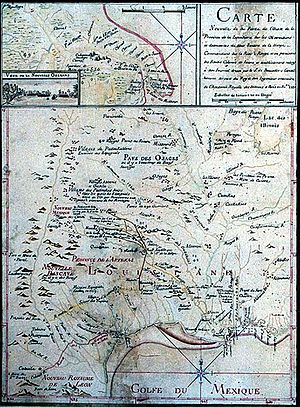Jean-Baptiste Bénard de la Harpe facts for kids
Jean-Baptiste Bénard de la Harpe (born February 4, 1683, in Saint-Malo – died September 26, 1765) was a brave French explorer. He is famous for discovering Little Rock, Arkansas. He was also the first known French explorer to step foot in the area that would later become the state of Oklahoma.
Contents
Exploring Oklahoma's Wild Lands
In 1718, La Harpe left France with 40 men. By April 1719, he had set up a trading post on the Red River. This spot was close to what is now Texarkana, Texas. It was also near the center of the Caddo Confederacy, a group of Native American tribes.
Journey to the Wichita Village
La Harpe hoped to create trade friendships with Native American tribes further away. So, on August 11, 1718, he started a new journey. He traveled with 9 men, including 3 Caddo guides, and 22 horses loaded with goods to trade. Their goal was to visit a Wichita village to the northwest. Around the same time, another French explorer, Claude Charles Du Tisne, also visited a different Wichita village in Kansas.
La Harpe followed the Red River upstream. He likely reached the area of modern-day Idabel, Oklahoma. Then, he turned north to cross the rough, hilly Ouachita Mountains. These mountains rise more than 300 meters (about 1,000 feet) above the valleys.
Encounters in the Mountains
While in the mountains, La Harpe met an Osage war party. He managed to avoid a fight with them. He also found signs that a "Cancey" (Apache) war party was in the area.
On September 3, after 23 days of travel, La Harpe and his group reached a large settlement. Experts have different ideas about where it was located. However, after a dig in 1988, archaeologist George H. Odell suggested it was about 21 kilometers (13 miles) south of Tulsa, Oklahoma. This spot was near the western bank of the Arkansas River.
Life in the Wichita Village
The settlement La Harpe visited had several villages overlooking the river. He guessed that 6,000 to 7,000 people lived there. Most of them were Tawakoni people. Other Wichita groups, like the Taovaya, were also present. Having many different Wichita tribes there suggests the village was a busy trade center for the whole region.
The Wichita people welcomed La Harpe warmly. They were so friendly that two Black slaves in his group wanted to stay with the Native Americans. La Harpe noticed that the Wichita had horses and were excellent farmers. He also saw that there was plenty of game (animals for hunting) in the area. While La Harpe was in the Wichita village, a Chickasaw trader visited. This worried La Harpe because the Chickasaw, who lived in Mississippi, were allies of the British.
Returning from the Expedition
La Harpe left the Wichita village on September 13, 1719. He arrived back at his starting point on October 13. On the way, an Apache group killed a Native American man and woman traveling with him. La Harpe also got lost in the mountains and had to eat his horses to survive.
La Harpe's journey was very important. It was one of the first two times the French made contact with the Wichita and Apache Native Americans. It was also the first known French trip into the area that would become Oklahoma. La Harpe's notes from his trip give us a lot of information. They describe the land he traveled through and the Native Americans he met. The Wichita people likely lived in such a large village to protect themselves from slave raids by the Osage and Apache. Within a few decades, the Wichita moved south to the Red River. There, they became allies with the Comanche people.
Exploring Texas's Coastline
In 1721, La Harpe drew the earliest known map of Galveston Island and Galveston Bay. At that time, he was trying to set up a French presence in the area, but he was not successful. That map, or a copy of it, is now kept at the Rosenberg Library in Galveston. On La Harpe's map, Galveston Island doesn't have a name, but it's easy to spot.
According to the Handbook of Texas Online, La Harpe's ship, the Subtile, was supposed to go to Matagorda. It ended up in Galveston Bay by mistake. This early mention of (or possible landing on) Galveston Island is not often talked about in history books. This is different from other well-known early contacts between Europeans and Galveston Island, like those by Cabeza de Vaca or even La Salle.
Discoveries in Arkansas
In 1722, La Harpe traveled up the Arkansas River. He found two distinct rock formations. The smaller one was on the South bank, and he named it Le petit rocher (The little rock). The larger one was on the North bank, and he called it le rocher francais (The French rock). He set up a trading post near the smaller formation. This was because a Quapaw Native American settlement was already there.
He explored the Arkansas River for another 25 leagues (about 115 kilometers or 70 miles) past Little Rock. He might have been the first explorer to discover Natural Steps, Arkansas. At that time, a large Quapaw village occupied this area.
Later in 1722, La Harpe oversaw the transfer of Pensacola, Florida to the Spanish. In 1723, he returned to France and never came back to the Americas.


